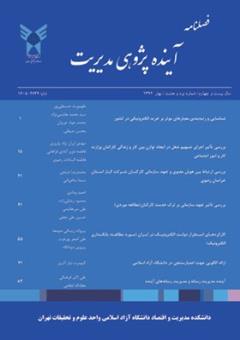آیندهپژوهی اثر شلاقی در زنجیره تأمین صنعت فرش ماشینی ایران
محورهای موضوعی : آینده پژوهی
1 - استادیار گروه مدیریت و کارآفرینی، دانشکده علوم انسانی، دانشگاه کاشان، کاشان، ایران
کلید واژه: زنجیره تأمین, فرش ماشینی, اثر شلاقی, آیندهپژوهی,
چکیده مقاله :
زمینه: زنجیره تأمین فرش ماشینی در سالهای اخیر با نوسانات متعددی روبرو بوده است. یکی از مهمترین نوسانات، اثر شلاقی است. آیندهپژوهی این اثر در زنجیره تأمین میتواند تصمیمگیرندگان را برای مقابله با سناریوهای محتمل آماده نماید. این تحقیق در صنعت فرش ماشینی ایران اجرا شده است. هدف: آیندهپژوهی اثر شلاقی در زنجیره تأمین صنعت فرش ماشینی ایران روش ها: جامعه اماری این تحقیق خبرگان صنعت فرش ماشینی ایران هستند که به روش قضاوتی و گلوله برفی انتخاب شده اند. برای تحلیل مصاحبه ها از تحلیل تم و برای آیندهپژوهی از نرمافزارهای میک مک و سناریو ویزارد استفاده گردید. یافته ها: نتایج مصاحبه نشان داد که ۱۰ پیشران برای اثر شلاقی در زنجیره تأمین وجود دارد که ۹ تای آن توسط نرمافزار میک مک به عنوان پیشرانهای مهم انتخاب شدند. از ۱۱5۲ سناریوی ممکن، ۳ سناریو برای آینده این متغیر مشخص شدند که یک سناریو مطلوب، یک سناریو نامطلوب و یک سناریو حد وسط است. نتیجه گیری: در نهایت پیشنهادهایی همچون کاهش زمان راهاندازی، بهبود روشهای پیشبینی تقاضا، تغییر سیاست بازپرسازی، تخفیفات مبتنی بر حجم به جای تخفیفات مبتنی بر دسته و مدیریت موجودی توسط فروشندگان برای تحقق سناریوی مطلوب و دوری از سناریوی نامطلوب ارائه گردید.
Background: The supply chain of machine-made carpets has faced several fluctuations in recent years. One of the most important fluctuations is the bullwhip effect. Future study of bullwhip effect in the supply chain can prepare decision makers to deal with possible scenarios. This research has been carried out in the Iranian machine-made carpet industry. Objective: Future study of the bullwhip effect in the supply chain of Iran's machine-made carpet industry Methods: The statistical population of this research is the experts of Iranian machine carpet industry who have been selected by judgment and snowball method. Theme analysis was used to analyze the interviews and Micmac and Scenariowizard software were used for future study. Results: The results of the interview showed that there are 10 drivers for bullwhip effect in the supply chain, 9 of which were selected as important drivers by Micmac software. Out of 1152 possible scenarios, 3 scenarios were consistent, which are a favorable scenario, an unfavorable scenario and a median scenario. Conclusion: Finally, suggestions such as reducing start-up time, improving demand forecasting methods, changing the replenishment policy, volume-based discounts instead of batch-based discounts, and vendor inventory management were presented to achieve the desired scenario and avoid the unfavorable scenario.

